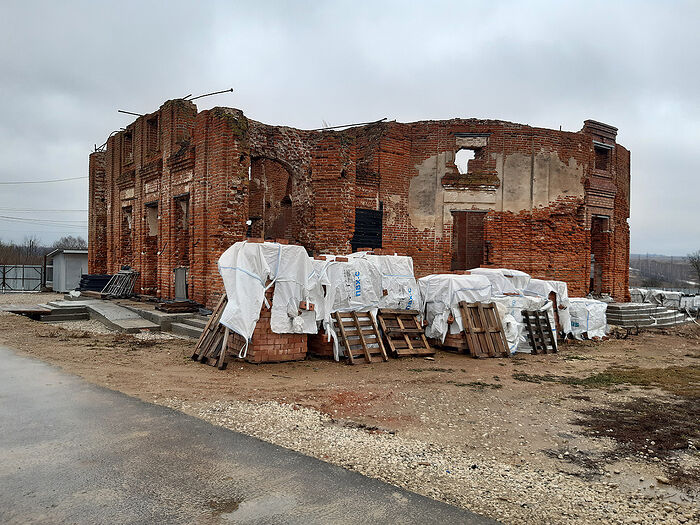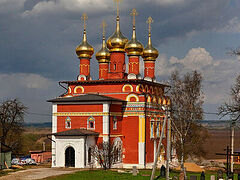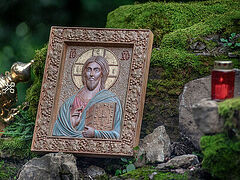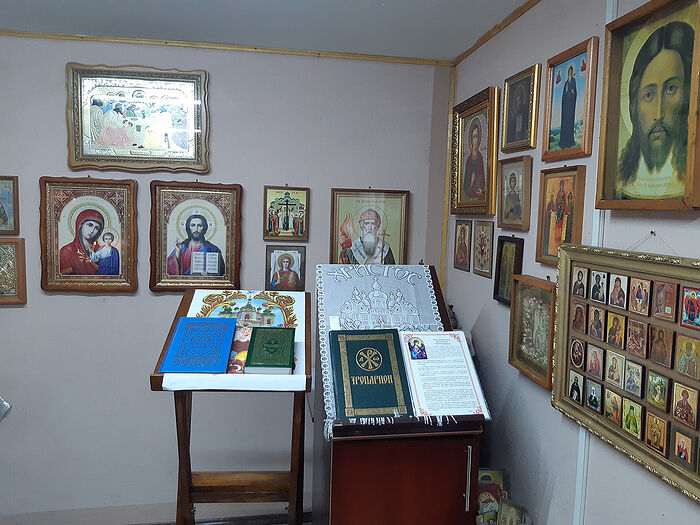 In the prayer trailer at the church
In the prayer trailer at the church
—Does your church have any major benefactors?
—Of course, organizations and individual entrepreneurs help us. But there are no permanent benefactors. I call, come to appointments and ask. Some people ask me, “Does the diocese help you?” I answer them, “Do you go to church?” They say, “Well... I go on Theophany, on Pascha...” I reply, “If that’s the case, where can the diocese get funds to help us?” I know that I might get refused, but I still knock at all possible doors. I couldn’t get to one large company for several years: they just didn’t make me any appointments. They still don’t; they just let me in, and as a rule, give me what I ask for. We have a minimal program before us: to restore the walls and enter under the church roof. The metal rolling plant gives us reinforcements. Many people help us with materials: with gravel, sand, asphalt, etc. Some organizations pay our bills for building materials. But many of them do not want any publicity—they do it for the glory of God!
—What does the church particularly need now?
—We are having difficulty raising funds for the bells. Already during the construction of the bell tower we must install the main large bell of the church; later it will be impossible to hang it there. I am sending petitions to the heads of organizations, enterprises, and institutions, but they are mostly passive. Ordinary people respond more actively. Like the poor widow from the Gospel, ordinary people will sacrifice their last fifty rubles, which we enormously appreciate! That’s how we are collecting funds for the small belfry—kopeck by kopeck, through the Archangel Michael Fund, and people contribute. We want to start holding services as soon as it becomes possible so that the church can have its voice. At present, we only hold prayer services in the tiny chapel we built near the church.
—Judging by the restoration project, the Church of the Exaltation of the Cross has very interesting architecture—two bell towers…
—Yes. And the church building is a circle inside a circle. It is very rare: a rotunda, that is, a round building, can still be found in the church architecture of Classicism, but we have two rotundas: internal and external. The church has three altars: one is dedicated to the Exaltation of the Holy Cross, another to the Kazan Icon of the Most Holy Theotokos, and a third to St. Alexei, Metropolitan of Moscow. The last was not dedicated by coincidence. At one time, the Ignatiev family, whose ancestor was the boyar Fyodor Byakont, had an estate here. His son Theophan was nicknamed Pleshchei—the Pleshcheyev family descended from him. Theophan Fyodorovich Pleshcheyev’s brother, Elevfery Fyodorovich (1293–February 12, 1378), from childhood found his mission in the service of the Lord. We know him as a great God-pleaser—St. Alexei, Metropolitan of Moscow and All Russia—a wonderworker in whose honor in 1808 the north chapel of our Church of the Exaltation of the Cross was consecrated in the village of Yakovlevskoye, which later was renamed Leninsky, on the outskirts of Tula. Then the estate belonged to the Mansurovs. There were a manor farm, a pond, a garden and a distillery. The elder brother, Dmitry Sergeyevich Mansurov, was the chief of the provincial nobility. The youngest, Alexei Sergeyevich, married his peasant serf. They had three children and adopted a son from the nobility. He signed the documents for his adoptive mother, who remained illiterate. These are the episodes from the past that I found out while searching for information about the church in the archives.
—Tell us about the Church of St. Alexander Nevsky, which stands next to the Church of the Exaltation of the Cross—the same ruins…
—God willing, we hope that it will be restored as well. It was a classic pair: the unheated summer Church of the Exaltation of the Cross and the heated winter St. Alexander Nevsky Church. Interestingly, this church used to be the greenhouse of the Mansurov landowners. If you look at it, you will see that there are a lot of windows, and the altar is attached to the south side. In 1864, the new owner of the estate, Anna Petrovna Bykova, at the request of a local priest, Fr. Mikhail Sobolev, allowed him to convert this building into a church. The greenhouse was turned into a church in two years. When it was consecrated, Bishop Ambrose of Tula arrived. The surrounding nobles gathered for the consecration of the church. Peasants stood outside on platforms that had been installed at the window level so that they could participate in worship as well. Tables with treats for common people were set up in the alley between the two churches. The peasants said, “We will tell our children and grandchildren that we felt as if we had been in Paradise.” The bishop who consecrated the church expressed gratitude to the priest and parishioners for their diligence, saying that in some villages, the inhabitants could not maintain one church properly, but in Yakovlevskoye they wished to have two, and both were nicely furnished.
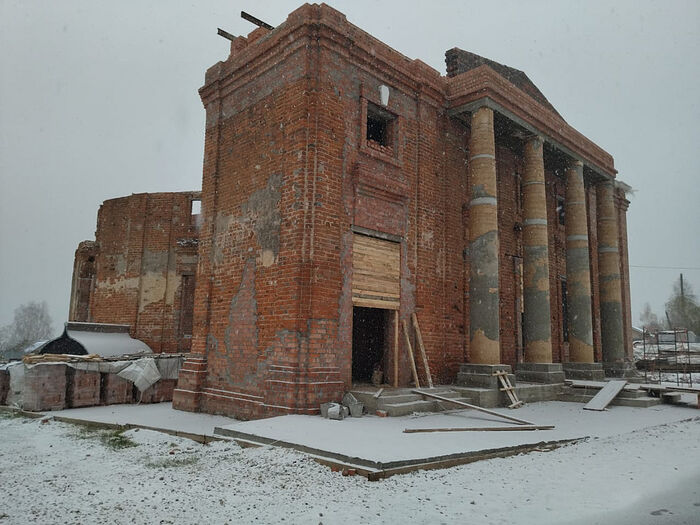 Much was done over the summer of 2023
Much was done over the summer of 2023
—How did the churches end up in such a badly destroyed state?
—In the Soviet era there were particularly zealous atheists here, who strove to justify the village’s name—Leninsky (named after Lenin). The churches were being purposefully destroyed even as late as the 1960s. The believing villagers tried to defend them, but in vain; the atheists brought special equipment, striking at the walls, domes and columns with a demolition ball. They collapsed inside. And imagine how durable the masonry was—when we were dismantling the fallen columns, they didn’t yield to a drill! Immediately after the Revolution there was a struggle for the churches for some time. According to a surviving document, on March 21, 1922, members of the parish community of the village of Yakovlevskoye declared: “We wish to preserve our Orthodox religion with all its cult, and therefore we accept the church with all its furniture from the Government for preservation and commit ourselves to maintaining the church buildings in proper order and to preserve all church property.” They must have had a lot of courage! But, alas, in 1928 and 1930 the churches were closed.
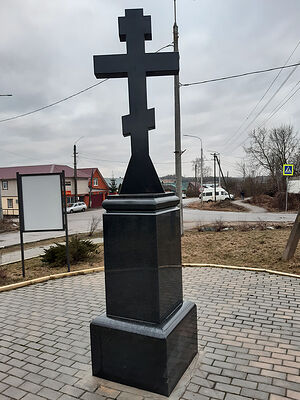 The memorial cross in a public garden near the church —When I approached the Church of the Exaltation of the Cross, I saw a public garden with a memorial cross. What is it dedicated to?
The memorial cross in a public garden near the church —When I approached the Church of the Exaltation of the Cross, I saw a public garden with a memorial cross. What is it dedicated to?
—We want everything to be beautiful and gracious. After all, it is located at the entrance to historical monuments: two churches and a former manor house. More recently, there was a dumping ground where the public garden is now situated. By 2019, we had cleared the church grounds and started putting the surrounding area in order. I made a project, found a tractor, and the administration provided us with woodcutters. Work began. Soon a stranger came up to me and said, “I want to buy out this area and give it to the church.” I refused, because historically this area didn’t belong to the church, but to the village. I said, “If you want, help me purchase a memorial cross for the public garden.” Not only did he pay for it, but he also arranged all the work in the public garden at his own expense, and now he is involved in the restoration of the church. And he doesn’t want his name to be mentioned anywhere.
—The restoration of a church is a job that requires a great deal of special knowledge. Where did you acquire it?
—We have to learn a much very gradually. The Lord helps us. To sort out a particular issue, He sends us people who help with counsel or provide practical assistance. One person cannot know everything. For example, organizations have a staff of specialists in various fields. And here I have faithful friends in God: builders, engineers, gas workers, electricians, land surveyors, lawyers, etc., who take part in the restoration of the church for free. Of course, I delve into everything, learning something I didn’t know before. That’s how I’m learning. And I’m interested in all this! Glory to God for everything!

